2014 LINCOLN MKZ HYBRID weight
[x] Cancel search: weightPage 131 of 445
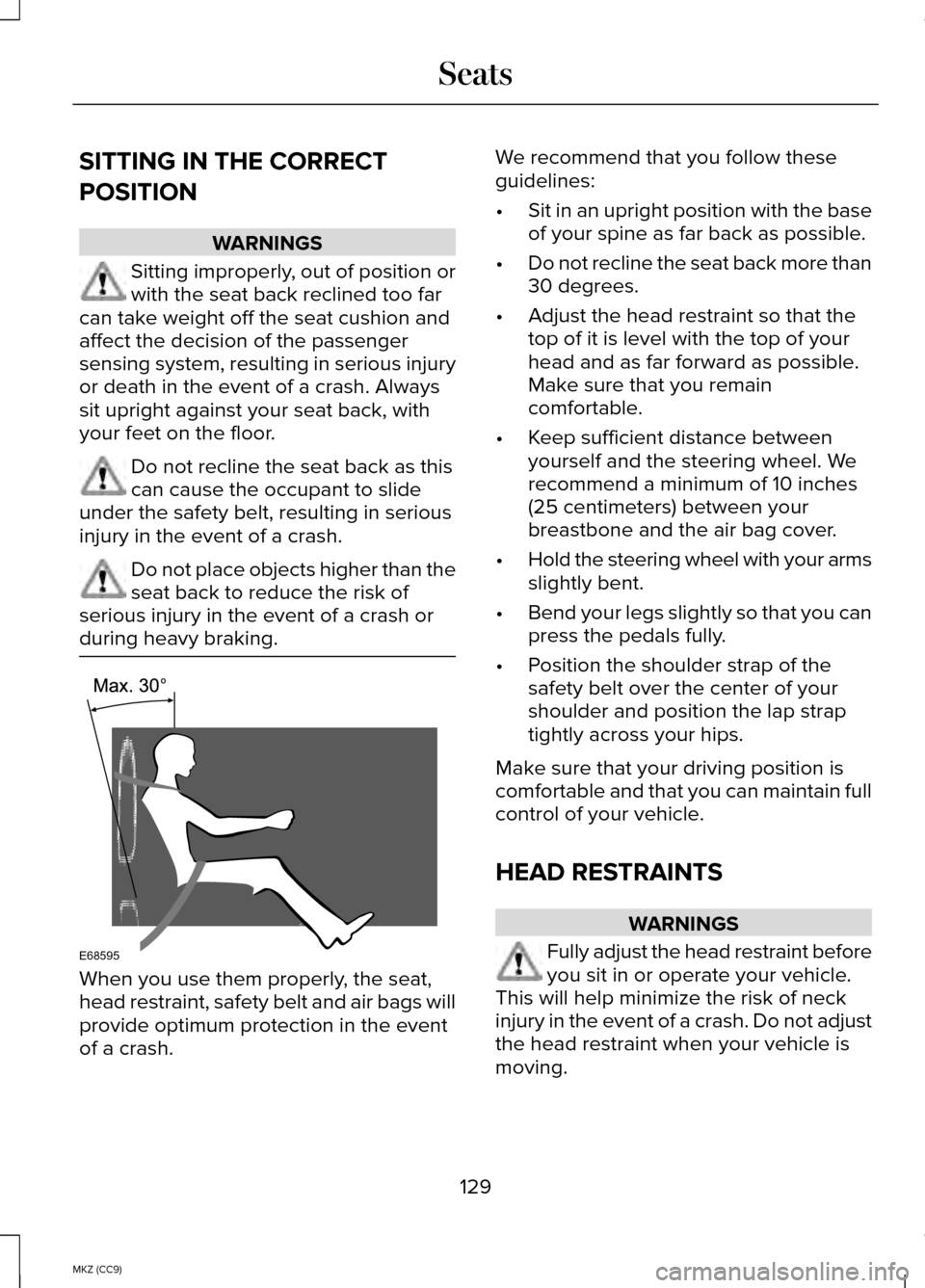
SITTING IN THE CORRECT
POSITION
WARNINGS
Sitting improperly, out of position or
with the seat back reclined too far
can take weight off the seat cushion and
affect the decision of the passenger
sensing system, resulting in serious injury
or death in the event of a crash. Always
sit upright against your seat back, with
your feet on the floor. Do not recline the seat back as this
can cause the occupant to slide
under the safety belt, resulting in serious
injury in the event of a crash. Do not place objects higher than the
seat back to reduce the risk of
serious injury in the event of a crash or
during heavy braking. When you use them properly, the seat,
head restraint, safety belt and air bags will
provide optimum protection in the event
of a crash. We recommend that you follow these
guidelines:
•
Sit in an upright position with the base
of your spine as far back as possible.
• Do not recline the seat back more than
30 degrees.
• Adjust the head restraint so that the
top of it is level with the top of your
head and as far forward as possible.
Make sure that you remain
comfortable.
• Keep sufficient distance between
yourself and the steering wheel. We
recommend a minimum of 10 inches
(25 centimeters) between your
breastbone and the air bag cover.
• Hold the steering wheel with your arms
slightly bent.
• Bend your legs slightly so that you can
press the pedals fully.
• Position the shoulder strap of the
safety belt over the center of your
shoulder and position the lap strap
tightly across your hips.
Make sure that your driving position is
comfortable and that you can maintain full
control of your vehicle.
HEAD RESTRAINTS WARNINGS
Fully adjust the head restraint before
you sit in or operate your vehicle.
This will help minimize the risk of neck
injury in the event of a crash. Do not adjust
the head restraint when your vehicle is
moving.
129
MKZ (CC9) SeatsE68595
Page 139 of 445

•
Press the heated seat symbol to cycle
through the various heat settings and
off. Warmer settings are indicated by
more indicator lights.
• Press again to deactivate.
The heated seat module resets at every
ignition run cycle. While the ignition is on,
press the high or low heated seat switch
to enable heating mode. When activated,
they will turn off automatically when you
turn the engine off.
VENTILATED SEATS (IF EQUIPPED)
The ventilated seats will only function
when the engine is running. To operate the ventilated seats:
Press the ventilated seat symbol to cycle
through the various cooling settings and
off. Cooler settings are indicated by more
indicator lights.
If the engine falls below 350 RPM while
the ventilated seats are on, the feature will
turn itself off and you will need to
reactivate it. Heated and ventilated seat air filter
replacement (if equipped)
Your vehicle is equipped with lifetime air
filters that are integrated with the seats.
Regular maintenance or replacement is
not needed.
REAR SEAT ARMREST
Fold the armrest down to use the armrest
and cupholder. To open the storage lid,
pull up on the latch located between the
cupholders.
Armrest pass-through
Note:
Do not exceed 80 pounds (36
kilograms) of weight on the pass-through
door.
137
MKZ (CC9) SeatsE146309 E144635
Page 216 of 445
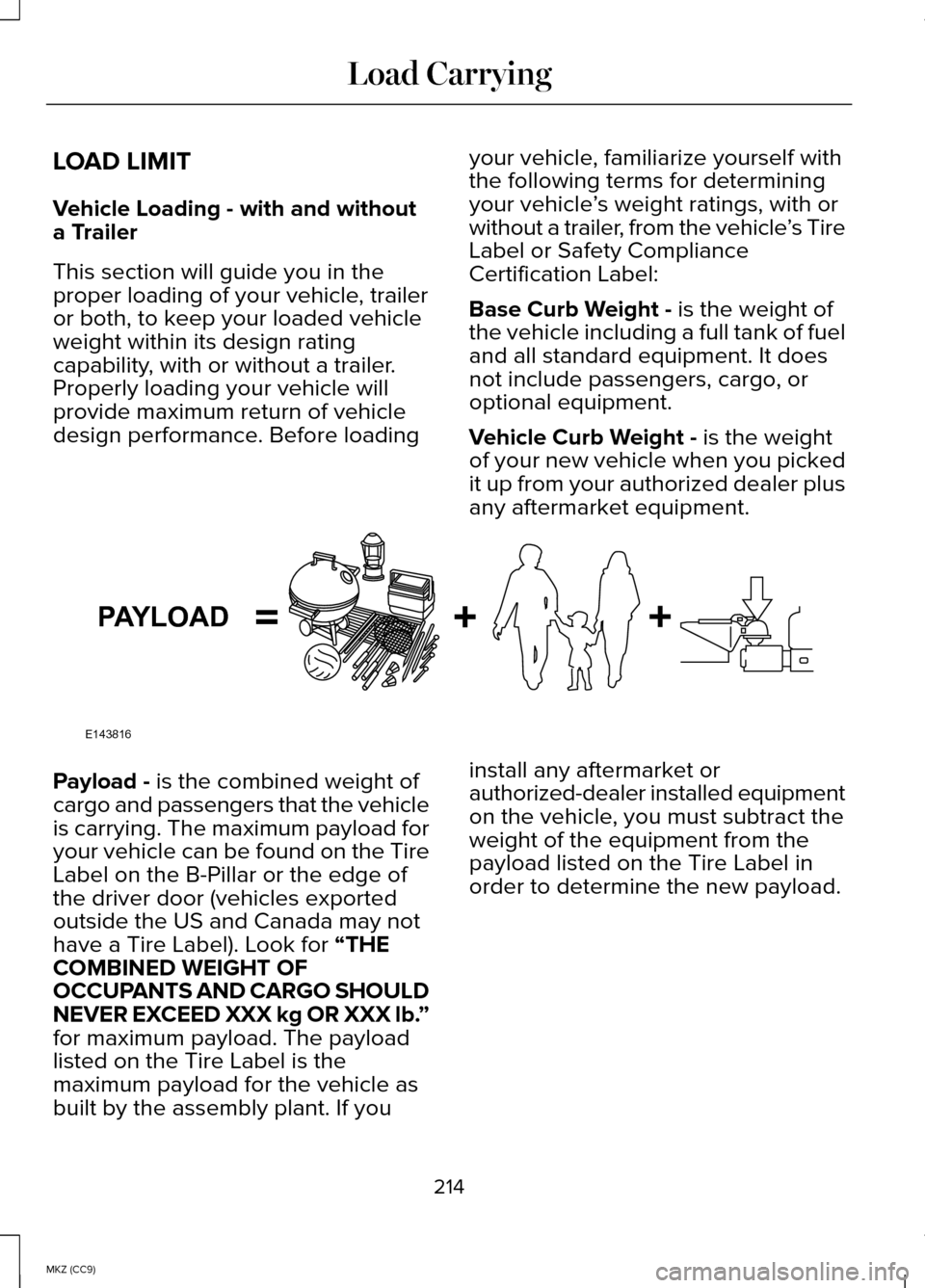
LOAD LIMIT
Vehicle Loading - with and without
a Trailer
This section will guide you in the
proper loading of your vehicle, trailer
or both, to keep your loaded vehicle
weight within its design rating
capability, with or without a trailer.
Properly loading your vehicle will
provide maximum return of vehicle
design performance. Before loading
your vehicle, familiarize yourself with
the following terms for determining
your vehicle
’s weight ratings, with or
without a trailer, from the vehicle ’s Tire
Label or Safety Compliance
Certification Label:
Base Curb Weight - is the weight of
the vehicle including a full tank of fuel
and all standard equipment. It does
not include passengers, cargo, or
optional equipment.
Vehicle Curb Weight -
is the weight
of your new vehicle when you picked
it up from your authorized dealer plus
any aftermarket equipment. Payload -
is the combined weight of
cargo and passengers that the vehicle
is carrying. The maximum payload for
your vehicle can be found on the Tire
Label on the B-Pillar or the edge of
the driver door (vehicles exported
outside the US and Canada may not
have a Tire Label). Look for
“THE
COMBINED WEIGHT OF
OCCUPANTS AND CARGO SHOULD
NEVER EXCEED XXX kg OR XXX lb. ”
for maximum payload. The payload
listed on the Tire Label is the
maximum payload for the vehicle as
built by the assembly plant. If you install any aftermarket or
authorized-dealer installed equipment
on the vehicle, you must subtract the
weight of the equipment from the
payload listed on the Tire Label in
order to determine the new payload.
214
MKZ (CC9) Load CarryingE143816PAYLOAD
Page 217 of 445

WARNING
The appropriate loading capacity
of your vehicle can be limited
either by volume capacity (how much
space is available) or by payload
capacity (how much weight the vehicle
should carry). Once you have reached
the maximum payload of your vehicle,
do not add more cargo, even if there
is space available. Overloading or
improperly loading your vehicle can
contribute to loss of vehicle control
and vehicle rollover. Example only:
215
MKZ (CC9) Load CarryingE142516 E142517
Page 218 of 445
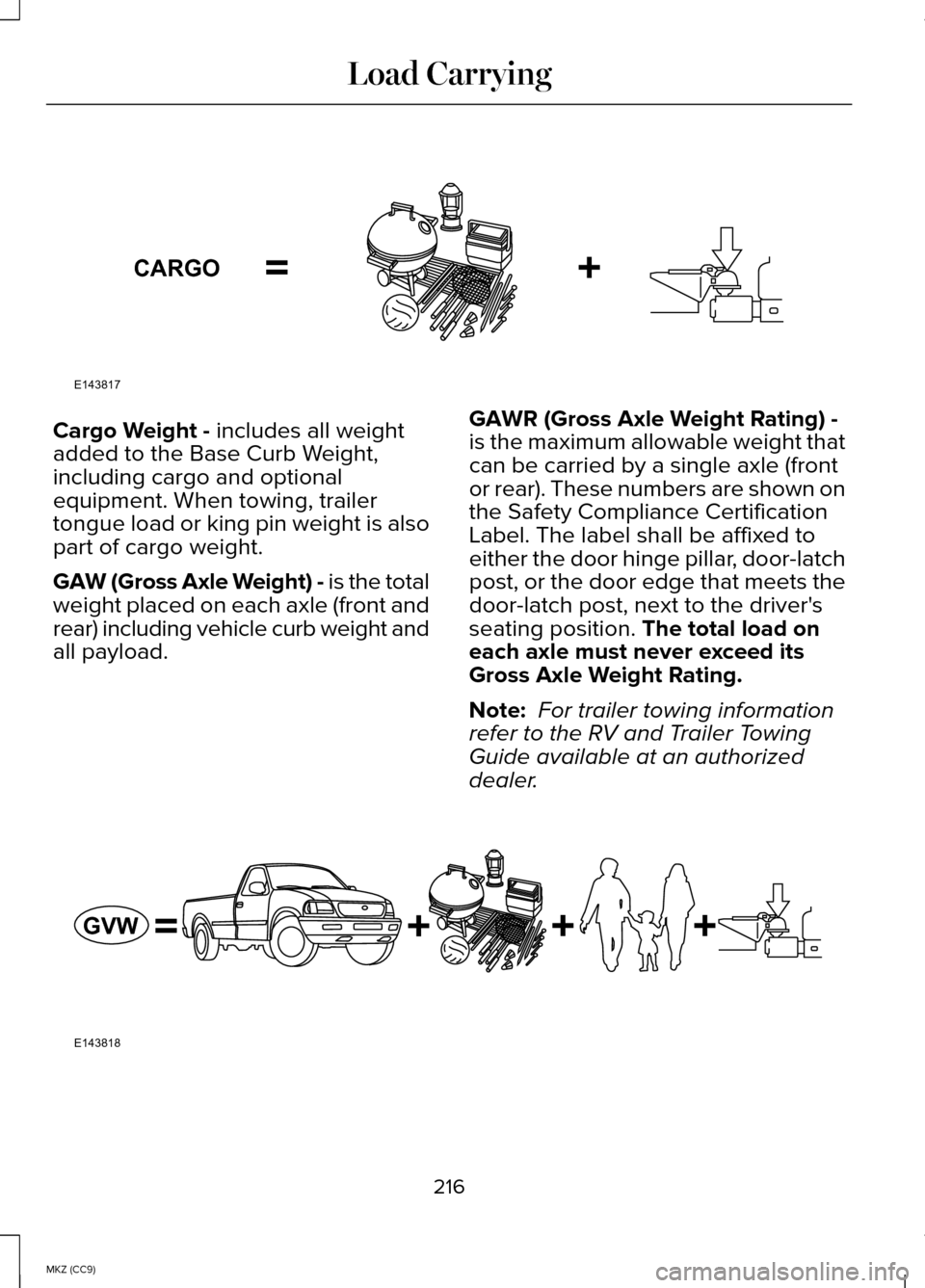
Cargo Weight - includes all weight
added to the Base Curb Weight,
including cargo and optional
equipment. When towing, trailer
tongue load or king pin weight is also
part of cargo weight.
GAW (Gross Axle Weight) - is the total
weight placed on each axle (front and
rear) including vehicle curb weight and
all payload. GAWR (Gross Axle Weight Rating) -
is the maximum allowable weight that
can be carried by a single axle (front
or rear). These numbers are shown on
the Safety Compliance Certification
Label. The label shall be affixed to
either the door hinge pillar, door-latch
post, or the door edge that meets the
door-latch post, next to the driver's
seating position.
The total load on
each axle must never exceed its
Gross Axle Weight Rating.
Note: For trailer towing information
refer to the RV and Trailer Towing
Guide available at an authorized
dealer. 216
MKZ (CC9) Load CarryingE143817CARGO E143818GVW
Page 219 of 445
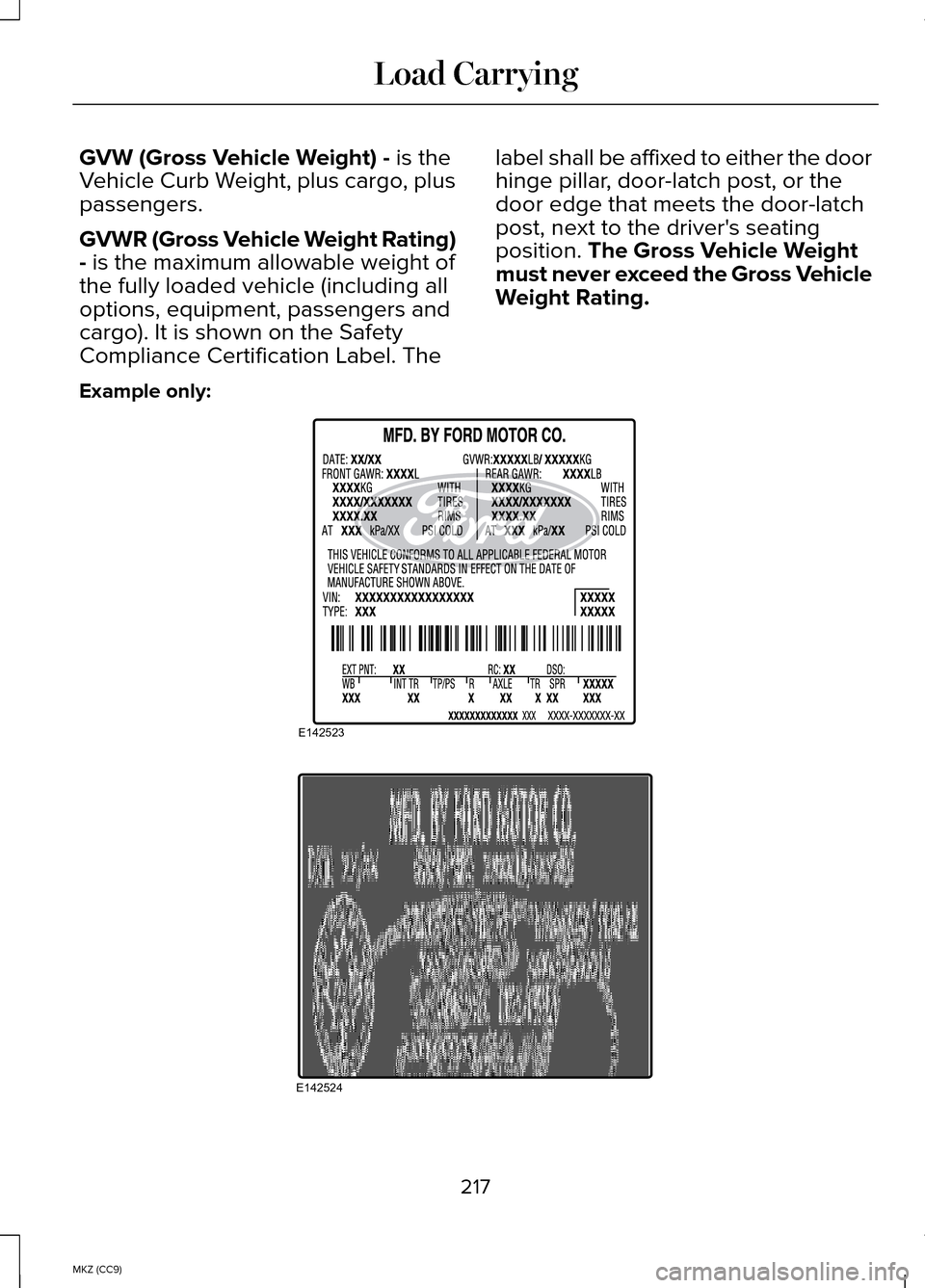
GVW (Gross Vehicle Weight) - is the
Vehicle Curb Weight, plus cargo, plus
passengers.
GVWR (Gross Vehicle Weight Rating)
-
is the maximum allowable weight of
the fully loaded vehicle (including all
options, equipment, passengers and
cargo). It is shown on the Safety
Compliance Certification Label. The label shall be affixed to either the door
hinge pillar, door-latch post, or the
door edge that meets the door-latch
post, next to the driver's seating
position. The Gross Vehicle Weight
must never exceed the Gross Vehicle
Weight Rating.
Example only: 217
MKZ (CC9) Load CarryingE142523 E142524
Page 220 of 445
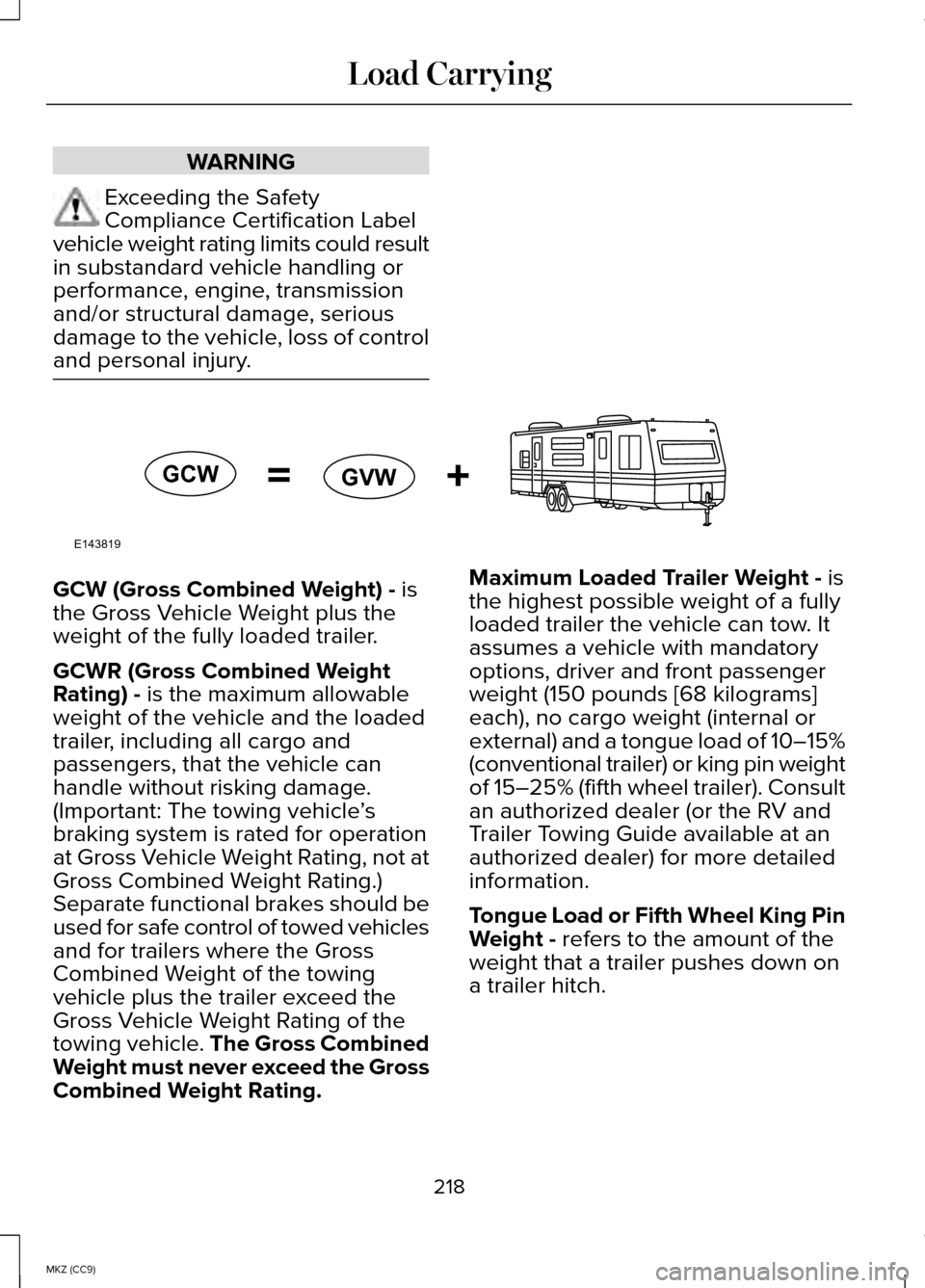
WARNING
Exceeding the Safety
Compliance Certification Label
vehicle weight rating limits could result
in substandard vehicle handling or
performance, engine, transmission
and/or structural damage, serious
damage to the vehicle, loss of control
and personal injury. GCW (Gross Combined Weight) - is
the Gross Vehicle Weight plus the
weight of the fully loaded trailer.
GCWR (Gross Combined Weight
Rating) -
is the maximum allowable
weight of the vehicle and the loaded
trailer, including all cargo and
passengers, that the vehicle can
handle without risking damage.
(Important: The towing vehicle ’s
braking system is rated for operation
at Gross Vehicle Weight Rating, not at
Gross Combined Weight Rating.)
Separate functional brakes should be
used for safe control of towed vehicles
and for trailers where the Gross
Combined Weight of the towing
vehicle plus the trailer exceed the
Gross Vehicle Weight Rating of the
towing vehicle. The Gross Combined
Weight must never exceed the Gross
Combined Weight Rating. Maximum Loaded Trailer Weight -
is
the highest possible weight of a fully
loaded trailer the vehicle can tow. It
assumes a vehicle with mandatory
options, driver and front passenger
weight (150 pounds [68 kilograms]
each), no cargo weight (internal or
external) and a tongue load of 10–15%
(conventional trailer) or king pin weight
of 15–25% (fifth wheel trailer). Consult
an authorized dealer (or the RV and
Trailer Towing Guide available at an
authorized dealer) for more detailed
information.
Tongue Load or Fifth Wheel King Pin
Weight -
refers to the amount of the
weight that a trailer pushes down on
a trailer hitch.
218
MKZ (CC9) Load CarryingE143819GCW
GVW
Page 221 of 445

Examples: For a 5000 pound (2268
kilogram) conventional trailer, multiply
5000 by 0.10 and 0.15 to obtain a
proper tongue load range of 500 to
750 pounds (227 to 340 kilograms).
For an 11500 pound (5216 kilogram)
fifth wheel trailer, multiply by 0.15 and
0.25 to obtain a proper king pin load
range of 1725 to 2875 pounds (782 to
1304 kilograms). WARNINGS
Do not exceed the GVWR or the
GAWR specified on the Safety
Compliance Certification Label. Do not use replacement tires
with lower load carrying
capacities than the original tires
because they may lower the vehicle ’s
GVWR and GAWR limitations.
Replacement tires with a higher limit
than the original tires do not increase
the GVWR and GAWR limitations. Exceeding any vehicle weight
rating limitation could result in
serious damage to the vehicle and/or
personal injury. Steps for determining the correct
load limit:
1. Locate the statement "The
combined weight of occupants and
cargo should never exceed XXX
kg or XXX lb." on your vehicle ’s
placard.
2. Determine the combined weight
of the driver and passengers that
will be riding in your vehicle. 3. Subtract the combined weight of
the driver and passengers from
XXX kg or XXX lb.
4. The resulting figure equals the available amount of cargo and
luggage load capacity. For
example, if the “XXX” amount
equals 1,400 lb. and there will be
five 150 lb. passengers in your
vehicle, the amount of available
cargo and luggage load capacity
is 650 lb. (1400-750 (5 x 150) = 650
lb.)
5. Determine the combined weight
of luggage and cargo being loaded
on the vehicle. That weight may
not safely exceed the available
cargo and luggage load capacity
calculated in Step 4.
6. If your vehicle will be towing a
trailer, load from your trailer will be
transferred to your vehicle. Consult
this manual to determine how this
reduces the available cargo and
luggage load capacity of your
vehicle.
The following gives you a few
examples on how to calculate the
available amount of cargo and
luggage load capacity:
*Suppose your vehicle has a
1400-pound (635-kilogram) cargo and
luggage capacity. You decide to go
golfing. Is there enough load capacity
to carry you, four of your friends and
all the golf bags? You and four friends
average 220 pounds (99 kilograms)
each and the golf bags weigh
approximately 30 pounds (13.5
kilograms) each. The calculation would
219
MKZ (CC9) Load Carrying